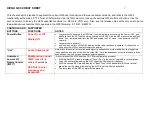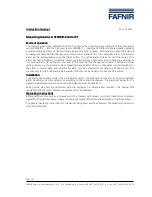
I-3
Technalogix Ltd
Operating Safeguards
It is a known fact that our broadcast transmitters and translators enjoy 50-ohm load
impedances. So much so, that it is imperative you maintain 50-ohm impedances throughout
your system. In return, your equipment will provide you with maximum power transfer to the
antenna and decreased reflected power heading back towards the amplifier pallets, reducing
the amount of magic smoke that gets let out of the power amplifier. Before anything is turned
on, ensure that there is a 50-ohm path from the output of each stage to the input of the next, all
the way to the antenna.
In addition to maintaining proper 50-ohm impedances throughout the signal chain, it is also
important, whenever possible, to make sure the RF drive going to the input of the power
amplifier is removed before turning on or turning off the DC power supply. This is because all of
the RF transistors used in the individual amplifier pallets are fabricated with LDMOS (Laterally
Diffused Metal Oxide Semiconductor) technology. Nice and linear yes, but they do not like to
make any RF power when their supply voltages are not within a specific range. When you first
turn your power amplifier on or off, the DC power supply’s output voltage may take a while to
stable out to a safe operating voltage. Ten seconds wait before applying the RF drive will
ensure no issues arise.
Our power amplifiers are designed to reliably generate a specific RF output power. Failing to
adhere to overdriven amplifier warnings can decrease the reliability of your system, and frankly,
makes our repair department busy and grumpy. If you need to transmit to a little larger
coverage, you are better off increasing antenna gain, and more importantly, antenna height
above average terrain. On TV and FM broadcast frequencies, insufficient antenna height puts
an upper limit on your range, regardless of power levels, as the
distance from your antenna to
the radio horizon is limited.
Summary of Contents for TAUD-100
Page 1: ...TAUD 1000 BROADCAST TRANSMITTER OPERATING MANUAL ...
Page 34: ......
Page 35: ......
Page 49: ......
Page 50: ......
Page 52: ...Technalogix Ltd Adrenaline Control System VI 31 Temp sensor 1 11 component layout Top ...
Page 53: ...Technalogix Ltd Adrenaline Control System VI 32 Temp sensor 1 11 component layout bottom ...
Page 58: ......
Page 59: ......
Page 62: ......
Page 63: ......
Page 69: ...Technalogix Ltd Adrenaline Control System VI 66 SNMP Configuration ...






































